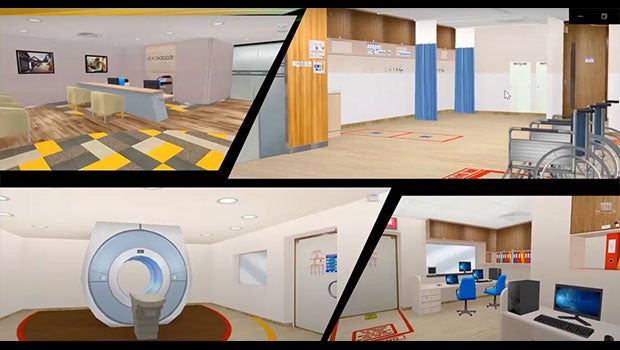
With its ability to recreate scenarios that are too dangerous and rare in real life, the first MRI Safety in Healthcare game has redefined how magnetic resonance safety training is conducted and raised the bar for how educational technology can shape the future of healthcare.
Something like a pacemaker or oxygen tank may seem harmless in ordinary circumstances, but once exposed to the strong magnetic field in a Magnetic Resonance Imaging (MRI) room, can become extremely dangerous to the patient and the people around them.
Magnetic Resonance (MR) accidents are rare, but the consequences can be severe and in the worst cases, lead to death. Safety procedures are therefore crucial, but without the ability to safely re-enact risky situations, it is difficult for staff who work in an MRI suite to grasp the gravity of the situation. However, this has changed with the development of the MRI Safety in Healthcare game.

Classified as a serious game, MRI Safety in Healthcare uses an immersive 3D learning environment to facilitate the learning of MR safety concepts through interactive gameplay and self-directed learning. Unlike regular games, the objective is to facilitate learning rather than to entertain.
Get updates on Tomorrow's Medicine in your mailbox!
Click here to subscribe
The transformational power of tech in MR Safety training
Since the introduction of the MRI Safety in Healthcare game, the Neuroradiology team at the National Neuroscience Institute (NNI) has found the quality of MR safety training to have improved.
As an MR Safety Trainer, Ms Oh Hui Ping, Principal Radiographer, NNI, shared that in the past, she found herself having to tirelessly repeat the severity and risks associated with MR work to both staff and patients.
“All I could do was keep repeating myself to emphasise the seriousness of any lapses and maybe show them some videos or news articles reporting MR safety accidents,” she recalled.
She added that she would be the one doing most of the talking with this conventional training method.
“Now, with the game, learners are triggered to think about different scenarios. They can connect the concepts to their work and ask relevant questions,” she said.
The difference, as summed up by Associate Professor Kevin Tan, Director of Education, NNI, is this: “They’re not just learning the facts, but how to apply it.”
This is exactly what Ms Oh and her neuroradiology colleagues hoped to achieve when they first embarked on their game development project.
The journey began in 2020 when Senior Executive and team leader Ms Cheng Qianhui saw the potential of using games to enhance MR safety education. To bring her idea to fruition, she responded to SingHealth Academy’s 2020 call for proposals to develop serious games. Upon selection, the team was awarded SkillsFuture Singapore Learning Technology Adoption Grant, via SingHealth Academy, to kickstart the project

Virtually closing the gap between knowledge and application
Emphasis was placed on making the 3D game as realistic as possible. The game was modelled after an actual NNI radiology suite, right down to the look and placement of medical devices.
As safety protocols dictate that learners are unable to enter the actual MR rooms before training is complete, the game helps them visualise the environment they will be working in, said Ms Cheng. When coupled with activities to drag and drop equipment to the correct zones, screen patients for ferromagnetic items, and more, it reinforces essential safety concepts through active learning.

Importantly, being in the virtual world allows the NNI team to recreate dangerous situations that would be impossible to do in real life. Now, learners can experience an authentic accident play out, identify the lapses that might occur, and decide on the action to take when a life is in danger in a safe space, Ms Cheng added.
The game has been adapted and rolled out at radiology departments at Singapore General Hospital, KK Women's and Children's Hospital, and Sengkang General Hospital.
The value of this project has been recognised by health profession educators. It received the Free Communications for Young Scholar Award Runner-Up in the Asia Pacific Medical Education Conference 2021, and the Special Mention Award in the Medical Education Grand Innovation Challenge 2019/20.
Grooming talent to drive digital change
This is not the first time SingHealth has leveraged technology to improve healthcare standards. However, to Assoc Prof Tan, the success of the MR safety game speaks volumes about the organisation’s digital and education strategy.
“We do not use technology just because it’s nice to have or looks fun. Technology must help us achieve a goal, and that goal is to find the best way to teach a particular topic or skill,” he emphasised.
Assoc Prof Tan also highlights the opportunities of these initiatives to groom people capable of driving change. “To impact more people, we need to galvanise our resources and support our staff in developing innovations.” he said.
He cited Ms Cheng’s role in the MR safety project as just one example of how SingHealth and NNI are doing this. Ms Cheng began her career as a research assistant, but as her interest in education grew, she was given the support to attend other educational technology courses—which sparked the inspiration for the MR safety game.
“After I got the grant, I also obtained support to take a Masters in Adult Learning course and applied the principles of adult learning when developing the game,” she said.
It is heartening to see Ms Cheng’s journey through SingHealth, Assoc Prof Tan reiterated. “I’m happy to see that within NNI we have different groups of people working to bring health profession education to the next level. It is encouraging to know that there are people in the younger generation and from non-traditional healthcare roles interested in building health profession education for the future.”
Get updates on Tomorrow's Medicine in your mailbox!
Click here to subscribe













 Get it on Google Play
Get it on Google Play